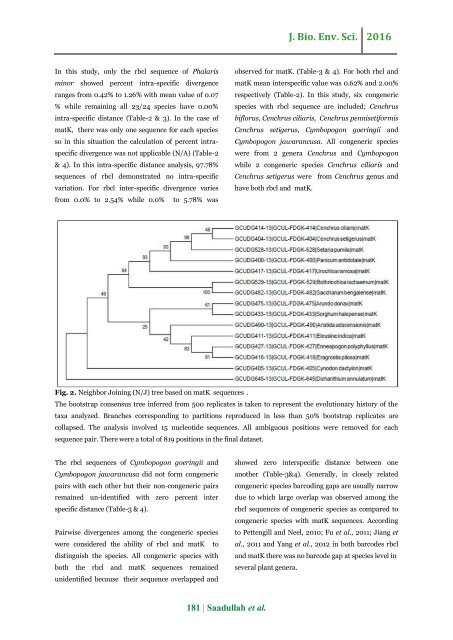Identification of the grass family (Poaceae) by using the plant dna barcodes rbcl and matK
Abstract Due to phenotypic plasticity, with few distinguishable and many overlapping characters, grasses are very difficult to identify by morphological characters, The current research evaluated how standard plant barcode rbcl and matK can help in floristic evaluation of. grasses belonging to a not well studied flora in district Dera Ghazi Khan, Punjab, Pakistan. In this study, 54 specimen belonging to 24 species of Poaceae were examined. Species wise sequencing success for rbcl and matK was 100% and 66.67% respectively. The determination of intra and inter-specific divergence and phylogentic analysis by reconstruction of neighbor joining trees were carried out. The results demonstrated that individually both rbcl and matK totally failed in discrimination of congeneric species. In neighbor joining phylogenetic analysis both rbcl and matK provided well resolved monophyletic tree with weak bootstrap threshold value. While in combination (rbcl+matK) both marker provided well resolved monophyletic tree with strong bootstrap threshold value.
Abstract
Due to phenotypic plasticity, with few distinguishable and many overlapping characters, grasses are very difficult to identify by morphological characters, The current research evaluated how standard plant barcode rbcl and matK can help in floristic evaluation of. grasses belonging to a not well studied flora in district Dera Ghazi Khan, Punjab, Pakistan. In this study, 54 specimen belonging to 24 species of Poaceae were examined. Species wise sequencing success for rbcl and matK was 100% and 66.67% respectively. The determination of intra and inter-specific divergence and phylogentic analysis by reconstruction of neighbor joining trees were carried out. The results demonstrated that individually both rbcl and matK totally failed in discrimination of congeneric species. In neighbor joining phylogenetic analysis both rbcl and matK provided well resolved monophyletic tree with weak bootstrap threshold value. While in combination (rbcl+matK) both marker provided well resolved monophyletic tree with strong bootstrap threshold value.
You also want an ePaper? Increase the reach of your titles
YUMPU automatically turns print PDFs into web optimized ePapers that Google loves.
J. Bio. Env. Sci. 2016<br />
In this study, only <strong>the</strong> <strong>rbcl</strong> sequence <strong>of</strong> Phalaris<br />
minor showed percent intra-specific divergence<br />
ranges from 0.42% to 1.26% with mean value <strong>of</strong> 0.07<br />
% while remaining all 23/24 species have 0.00%<br />
intra-specific distance (Table-2 & 3). In <strong>the</strong> case <strong>of</strong><br />
<strong>matK</strong>, <strong>the</strong>re was only one sequence for each species<br />
so in this situation <strong>the</strong> calculation <strong>of</strong> percent intraspecific<br />
divergence was not applicable (N/A) (Table-2<br />
& 4). In this intra-specific distance analysis, 97.78%<br />
sequences <strong>of</strong> <strong>rbcl</strong> demonstrated no intra-specific<br />
variation. For <strong>rbcl</strong> inter-specific divergence varies<br />
from 0.0% to 2.54% while 0.0% to 5.78% was<br />
observed for <strong>matK</strong>. (Table-3 & 4). For both <strong>rbcl</strong> <strong>and</strong><br />
<strong>matK</strong> mean interspecific value was 0.62% <strong>and</strong> 2.00%<br />
respectively (Table-2). In this study, six congeneric<br />
species with <strong>rbcl</strong> sequence are included; Cenchrus<br />
biflorus, Cenchrus ciliaris, Cenchrus pennisetiformis<br />
Cenchrus setigerus, Cymbopogon goeringii <strong>and</strong><br />
Cymbopogon jawarancusa. All congeneric species<br />
were from 2 genera Cenchrus <strong>and</strong> Cymbopogon<br />
while 2 congeneric species Cenchrus ciliaris <strong>and</strong><br />
Cenchrus setigerus were from Cenchrus genus <strong>and</strong><br />
have both <strong>rbcl</strong> <strong>and</strong> <strong>matK</strong>.<br />
Fig. 2. Neighbor Joining (N/J) tree based on <strong>matK</strong> sequences .<br />
The bootstrap consensus tree inferred from 500 replicates is taken to represent <strong>the</strong> evolutionary history <strong>of</strong> <strong>the</strong><br />
taxa analyzed. Branches corresponding to partitions reproduced in less than 50% bootstrap replicates are<br />
collapsed. The analysis involved 15 nucleotide sequences. All ambiguous positions were removed for each<br />
sequence pair. There were a total <strong>of</strong> 819 positions in <strong>the</strong> final dataset.<br />
The <strong>rbcl</strong> sequences <strong>of</strong> Cymbopogon goeringii <strong>and</strong><br />
Cymbopogon jawarancusa did not form congeneric<br />
pairs with each o<strong>the</strong>r but <strong>the</strong>ir non-congeneric pairs<br />
remained un-identified with zero percent inter<br />
specific distance (Table-3 & 4).<br />
Pairwise divergences among <strong>the</strong> congeneric species<br />
were considered <strong>the</strong> ability <strong>of</strong> <strong>rbcl</strong> <strong>and</strong> <strong>matK</strong> to<br />
distinguish <strong>the</strong> species. All congeneric species with<br />
both <strong>the</strong> <strong>rbcl</strong> <strong>and</strong> <strong>matK</strong> sequences remained<br />
unidentified because <strong>the</strong>ir sequence overlapped <strong>and</strong><br />
showed zero interspecific distance between one<br />
ano<strong>the</strong>r (Table-3&4). Generally, in closely related<br />
congeneric species barcoding gaps are usually narrow<br />
due to which large overlap was observed among <strong>the</strong><br />
<strong>rbcl</strong> sequences <strong>of</strong> congeneric species as compared to<br />
congeneric species with <strong>matK</strong> sequences. According<br />
to Pettengill <strong>and</strong> Neel, 2010; Fu et al., 2011; Jiang et<br />
al., 2011 <strong>and</strong> Yang et al., 2012 in both <strong>barcodes</strong> <strong>rbcl</strong><br />
<strong>and</strong> <strong>matK</strong> <strong>the</strong>re was no barcode gap at species level in<br />
several <strong>plant</strong> genera.<br />
181 | Saadullah et al.





![Review on: impact of seed rates and method of sowing on yield and yield related traits of Teff [Eragrostis teff (Zucc.) Trotter] | IJAAR @yumpu](https://documents.yumpu.com/000/066/025/853/c0a2f1eefa2ed71422e741fbc2b37a5fd6200cb1/6b7767675149533469736965546e4c6a4e57325054773d3d/4f6e6531383245617a537a49397878747846574858513d3d.jpg?AWSAccessKeyId=AKIAICNEWSPSEKTJ5M3Q&Expires=1715518800&Signature=dPkd%2BVoVLO%2FcXwIjX5t9IAoJwis%3D)












